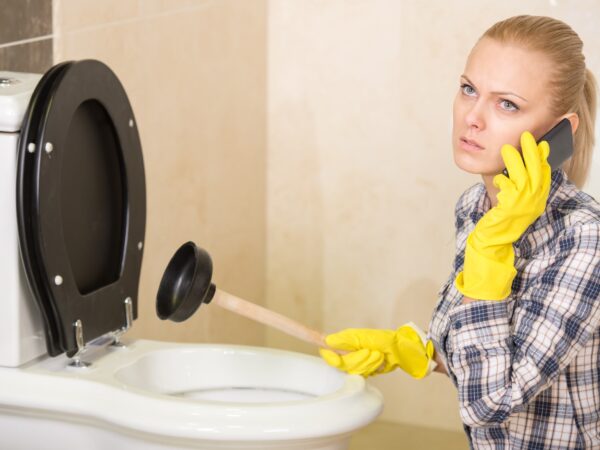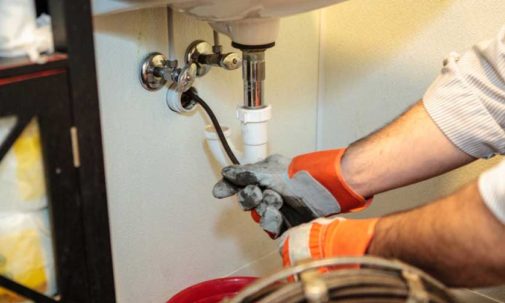We've discovered this great article involving What to Do While Waiting for an Emergency Plumber below on the net and felt it made good sense to share it with you over here.

Pipes emergency situations can strike at any moment, triggering tension and possible damage to your home. Whether it's a ruptured pipeline, a blocked drainpipe, or a dripping tap, recognizing just how to take care of the scenario until a professional plumbing technician gets here can conserve you from further problems. This post gives necessary emergency pipes suggestions to assist you mitigate damage and reclaim control during a pipes crisis.
Shut off the Water
The initial step in any type of pipes emergency situation is to turn off the water system. For local issues, such as a leaking tap or toilet, shut off the shutoff near the fixture. When it comes to a significant leakage or burst pipe, find your home's primary water shut-off shutoff and transform it off immediately. Knowing the place of these shutoffs ahead of time can conserve valuable time during an emergency.
Turn off Your Water Heater
In specific emergency situations, such as a ruptured pipeline, it's important to shut down your hot water heater. This stops getting too hot or damages to the unit when water quits flowing. Shut off the power supply to the hot water heater (electrical or gas) and allow it cool down to avoid prospective dangers.
Momentarily Stop a Ruptured Pipeline
A ruptured pipeline can cause substantial water damages in mins. To alleviate the problem:
- Clamp or Cover the Pipe: Utilize a pipe clamp, rubber, or air duct tape as a short-lived seal.
- Draw Away Water Circulation: Ideally, divert the water into a container or basin to limit damages to bordering locations.
- Maintain the Area Dry: Usage towels or a wet/dry vacuum cleaner to get rid of standing water.
- Call an expert plumbing technician promptly to attend to the issue permanently.
Have an Emergency Pipes Package
Prepare a fundamental plumbing emergency kit to take care of small problems efficiently. Your kit needs to consist of: - Adjustable wrench
- Plumbing's tape
- Pipe secures
- Towels and cloths
- A plunger
- Epoxy putty
- Bucket.
- Having these devices handy can make a considerable difference in your capacity to take care of emergencies.
Unclog Drains Securely.
A stopped up drain can be a frustrating and unpleasant problem. Here's just how to tackle it:. - Utilize a Plunger: For sinks or commodes, a plunger can frequently displace small blockages. Guarantee you use the proper kind of plunger for the component.
- Hot Water and Dish Soap: For grease-related blockages, pour a combination of warm water and dish soap away to break up the oil.
- Avoid Chemical Drainpipe Cleaners: While alluring, chemical cleaners can create more injury than great, especially to older pipes.
- If these methods do not work, prevent using too much force, as it might intensify the clog.
Manage Overflowing Toilets.
An overruning bathroom can create immediate disorder. Here's what you need to do:. - Stop the Water Circulation: Remove the storage tank lid and push down on the flapper valve to quit water from entering the dish. Turn off the water system to the commode if required.
- Dive Gently: Utilize a toilet plunger to get rid of the blockage, however stay clear of aggressive plunging, which can create splashing or additional damages.
- Include the Spill: Usage towels or a wipe to clean up water swiftly to prevent flooring damages.
Address Small Leaks with Short-term Solutions.
Tiny leaks can quickly end up being considerable troubles if left uncontrolled. Use these short-term repairs up until specialist aid gets here:.
- Pipe Tape or Epoxy Putty: Apply waterproof tape or epoxy putty to briefly seal the leakage.
- Rubber and Clamp Technique: Cover an item of rubber or an old internal tube around the leakage and safeguard it with a hose clamp or duct tape.
- Buckets or Towels: Place buckets under the leak to include water and avoid damage to floor covering or furnishings.
- While these repairs aren't permanent, they can help reduce water loss and damage.
Deal With Frozen Pipeline Thoroughly.
In chillier climates, frozen pipes are a common emergency. If you suspect a frozen pipeline:. - Switch off the Water: Shut down the primary supply of water to prevent a ruptured pipeline.
- Thaw Slowly: Make use of a hairdryer, hot pad, or warm towels to thaw the pipe gradually. Stay clear of open fires or extreme heat, as these can harm the pipe.
- Inspect for Leakages: Once the pipeline is thawed, check for splits or leakages before transforming the water back on.
Know When to Call a Specialist.
While quick fixes can assist temporarily, particular pipes issues call for instant expert attention. Call a plumbing professional if:.
- A burst pipe creates comprehensive flooding.
- Drains pipes or bathrooms remain clogged up in spite of your efforts.
- You see consistent leaks or water stress concerns.
- Your water heater is leaking or malfunctioning.
- Immediately calling a professional makes sure the issue is settled properly and protects against additional complications.
Stop Further Damages.
Taking quick activity to minimize damage can conserve you time and money in the future. Here's exactly how:. - Move Valuables: Eliminate furnishings, electronics, and various other products from the damaged area.
- Usage Sandbags: For flooding circumstances, place sandbags around the location to redirect water.
- Shut down Electrical energy: If water has gotten to electrical outlets or devices, shut off the electricity to avoid shocks or fires.
Conclusion.
Pipes emergency situations can be overwhelming, however with the right understanding and devices, you can manage the circumstance properly until assistance gets here. By turning off the water system, addressing small leakages, and making use of short-term repairs, you can decrease damage and keep your home safe. Bear in mind, these tips are short-term options; constantly speak with a certified plumbing technician to take care of the root cause of the problem. Preparation and fast reasoning are your ideal allies in any plumbing emergency situation.
Emergency Plumbing: Quick Steps to Minimize Damage Before Help Arrives
Welcome to ?our? helpful guide,? “Emergency Plumbing: Quick Steps ?to ?Minimize Damage ?Before Help? Arrives”. Plumbing emergencies can lead to unanticipated ?stress and potential property damage if not addressed promptly and effectively. However, ?while professional help is definitely essential? in? such situations, there are things that you ?can ?do ?to minimize damage ?before a? plumber arrives. In this detailed, informative,? and easily? understood post, we provide you with practical,? expert advice on ?how to mitigate the? impact of common? plumbing ?emergencies. From identifying? the problem? to implementing temporary fixes,? this ?guide ?can equip you? with the? knowledge? you ?need to ?act swiftly and ?decisively,? potentially saving you? a lot ?of time, ?money and heartache. Imbibe these? critical insights and turn them into action, because when it comes? to plumbing emergencies, every minute? counts!
Understanding the ?Urgency of Plumbing Emergencies
Regardless ?of how well-maintained your? plumbing system ?may be, emergencies can happen when least expected. ?Burst pipes, ?leaks, blocked drains, gas ?leaks, and water heater issues are just samples of circumstances that call for immediate professional ?help. What? do you do when such emergencies occur? Most? importantly, how do? you minimize damage before help arrives?
First? and? foremost, stop the water flow, this ?is the? most immediate way to prevent extensive water damage. Locate your ?home’s main water valve and turn it off. If? the emergency is? a localized one,? like a? sink overflow, turning off the specific fixture’s valve under the sink will suffice. Secondly, ?switch off the electricity. ?This is ?crucial, especially ?when the? water ?leak is ?close to electrical? outlets or appliances. Lastly, clear the area; move furniture, rugs, ?and other valuables out of the ?way, especially if they are at risk? of water damage.
Recognizing Common? Signs ?of Plumbing Issues
Recognizing plumbing issues as soon as? they emerge can ?save you? from pricey repairs and potential ?water damage. For ?instance, slow drainage might suggest a blockage in? your pipes that,? if not dealt with, could result in ?a damaging overflow. Keep an eye out for? continuous dripping from your faucet even when? turned off ?- this is a clear ?sign of a faucet? issue that’s wasting water and increasing your? bill. A toilet that frequently runs? or takes a ?long time to ?refill could hint at an inner? part malfunction, while ?unusual? sounds ?- banging, whistling or gurgling – coming from your pipes signal abnormal flow or air in? the pipe.?
Increasing water bills without extra usage is also a sign of a possible leak in the system ?that causes water wastage.? Noticeable water stains or lush patches ?in? your? yard might indicate an outdoor leak. Lastly, low water ?pressure could imply a clog, a pipe problem, or even a city supply issue. Recognizing ?these signs early can provide you with ?a valuable? opportunity to address minor issues before ?they exacerbate ?into major plumbing emergencies. ?Signs? of? Common Plumbing Issues: Slow drainage Continuous dripping from? faucets High? water bills Unusual noises from ?pipes Lush patches in? yard Low water ?pressure
Preparing? an Emergency Plumbing Kit for Quick Action
A well-equipped? emergency? plumbing kit can mean the difference? between a minor ?inconvenience ?and? a? significant home ?disaster. To be? prepared for unexpected plumbing? emergencies, your ?kit should carry all the ?essentials that can help you limit ?the damage before professional help? arrives. The ?golden rule is start with? the basics? and then ?add tools as you navigate through different plumbing problems. Following are the core essentials you must? have? in ?your emergency ?plumbing kit:
- Plunger: ? This ?is a versatile tool? that can clear most minor clogs in ?sinks, toilets and? drains.
- Pipe Wrench: Essential ?for tightening and loosening? glazed? pipes.
- Pliers: Handy for gripping? small objects.
- Screwdriver ?Set: Used for ?removing ?or? tightening different fixtures.
- Teflon ?Tape: ? Can be wrapped around? fittings? and joints to ?prevent minor? leaks.
- Bucket: A simple bucket can be used for multiple purposes from catching leaks ?to carrying tools or storing? removed? parts.
Effective DIY Methods to Minimize Damage Before Help Arrives
When you promptly recognize a plumbing emergency, you can employ several DIY methods ?to mitigate potential harm while waiting for a professional plumber. ?Initially, it’s crucial? to ?turn? off the water supply ?to ?stop further flooding. If you’re encountering a local problem—like a? record-breaking overflow? from your toilet—its dedicated ?water valve? will usually be ?located ?behind the fixture. However,? if the? issue seems to be? more pervasive, you can cut your ?whole house’s water supply,? typically found near ?your water meter or at the? street.

We were made aware of that report about Plumbing Emergencies: Tips on What To Do Before through a friend on our other web blog. Sharing is nice. Helping others is fun. Bless you for your time. Kindly pay a visit to our site back soon.
Schedule Appointment Now
Comments on “Fast Fixes for Plumbing Emergencies: What to Do Until Help Arrives”